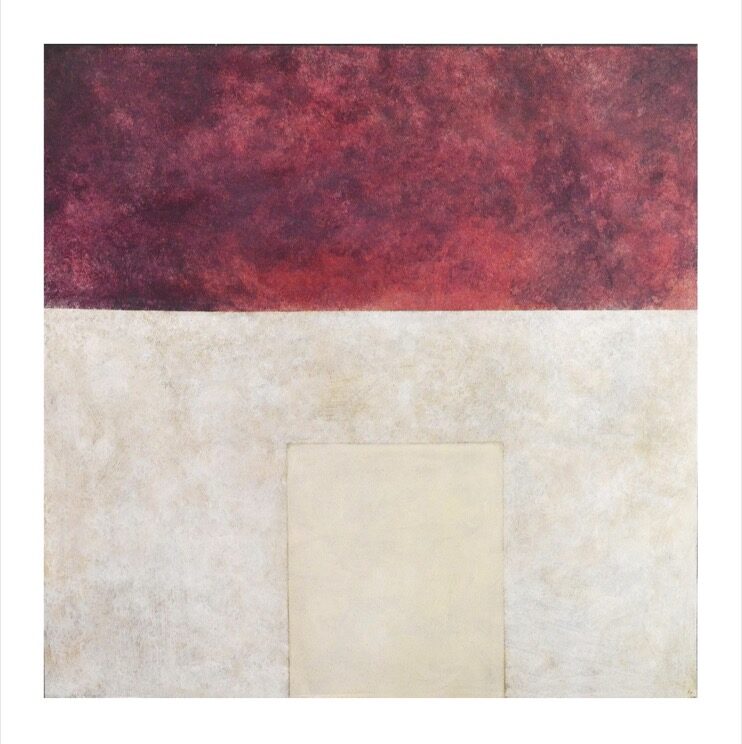Kiyomi Talaulicar’s artistic practice is an exploration of vulnerability, introspection, and self-reinvention. Her works are a dialogue between the seen and the unseen, where textures, negative space, and minimalism come together to create deeply contemplative visual experiences. Rooted in spontaneity, her process resists rigid preplanning, allowing each piece to evolve organically through instinct and response to the materials at hand.
Layered Abstraction and the Presence of Memory
Most of Talaulicar’s works are layered abstract compositions, where meaning unfolds gradually through the interaction of colour, space, and texture. While largely non-representational, some works include recognizable elements—a leaf, a chair, or a door. These elements do not function as direct symbols but rather as fragments of memories, surfacing from the layers like echoes of the past. They evoke a sense of nostalgia, hinting at personal relationships and experiences that have shaped her artistic journey. Her work becomes a meditation on time, where past and present intermingle within the textured depths of her canvases.
Minimalism and the Power of Negative Space
At the heart of Talaulicar’s aesthetic is minimalism, where negative space plays a critical role. Instead of crowding her compositions with overt visual narratives, she embraces emptiness as a force of meaning, inviting viewers to engage with what is not explicitly depicted. The spaces she leaves untouched are just as significant as the painted forms, offering an atmosphere of stillness and introspection. Her works prompt a meditative engagement, where the absence of detail becomes a gateway to deeper emotional resonance.
The Significance of Layering and Texture
Talaulicar’s process is one of building and erasing, of layering materials in a way that mirrors the complexity of existence. Each layer carries with it a history of choices—some concealed, some revealed—creating surfaces rich with depth and meaning. Her use of mixed media allows for varied tactile qualities, where textures emerge as silent witnesses to the passage of time and the unfolding of thought. This tactile interplay between the fragile and the resilient echoes the paradoxes of emotion: vulnerability coupled with strength, stillness counterbalanced by movement.
Colour as a Vessel of Emotion
Colour in Talaulicar’s work is a carefully considered element that conveys specific moods and states of contemplation. Her palette is often restrained, used sparingly to create contrasts that emphasize silence, presence, and emotion. Each hue serves a purpose, whether to evoke warmth, attachment, serenity, or tension. In her compositions, colour and form do not overwhelm; instead, they gently pull the viewer into an introspective space where subtleties unfold gradually.
Influence of Mexico: A Shift Toward Deeper Contemplation
A pivotal moment in Talaulicar’s artistic journey came from her time in Mexico, which profoundly impacted her approach to artmaking. The landscapes, architecture, and cultural essence of the country deepened her inclination toward contemplation and restraint. The emotional and physical textures she encountered there translated into her work, where stillness and subtlety became even more pronounced. This period refined her artistic voice, making her compositions more distilled and poignant.
Photography as a Reference Point
Photography plays an essential role in Talaulicar’s practice. The images she captures during her travels become points of reference, serving as inspiration rather than direct replication, guiding her thematic exploration. Her photographs serve as memory fragments, influencing the moods and compositions of her paintings. They are not literal blueprints but sparks that guide her towards the abstract, allowing her to distill emotions and fleeting impressions into her work.
The Unseen and the Felt
For Talaulicar, what remains hidden is just as crucial as what is revealed. Her work thrives on suggestion rather than explicit depiction, creating a realm where feelings take precedence over form. She seeks to evoke sensations that linger beyond the visual, engaging the viewer in an experience that is both personal and universal. The unseen elements in her work are meant to be felt rather than simply understood, making each piece an intimate, immersive encounter.
Spontaneity and the Flow of Creation
Central to Talaulicar’s approach is a resistance to over-planning. Her creative process is intuitive, allowing themes to unfold organically instead of being imposed into predetermined structures. Conceptually, a topic or theme must excite her to warrant further exploration in her practice. This organic evolution ensures that her work remains fresh, honest, and deeply connected to her state of mind at any given moment.
Strength in Fragility
There is a paradoxical duality in Talaulicar’s work—her pieces feel delicate yet carry immense strength. This fragility carries its own strength, a quiet resilience that asserts itself with subtle determination, a testament to the enduring nature of the spirit. Her compositions, though often subtle and restrained, possess a weight that lingers in the viewer’s consciousness. They are whispers that demand attention, silences that speak volumes.
Conclusion
Kiyomi Talaulicar’s art is an invitation to slow down, to engage with the unseen, and to embrace the layered complexities of existence. Through her use of negative space, texture, colour, and spontaneity, she crafts pieces that are deeply introspective and emotionally resonant. Her practice focuses not on grand statements but on the nuances of being—the spaces between thoughts, the pauses between breaths, the quiet strength found in vulnerability. In a world filled with noise, her art offers a sanctuary of contemplation, where what is hidden holds as much power as what is revealed.
